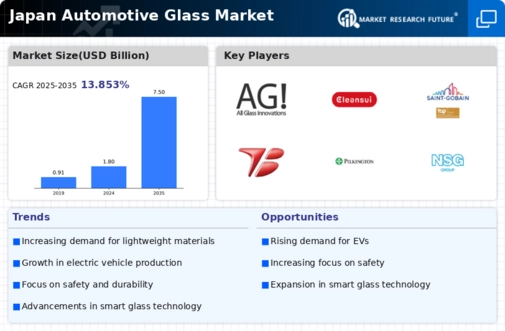The Japan Automotive Glass Market has been characterized by dynamic competition and innovation among various players. The industry involves the production and supply of glass products utilized in motor vehicles, including windshields, side windows, and rear windows.
Major companies are focusing on advanced technologies, enhanced safety features, and eco-friendly materials as consumer demands evolve. The competitive landscape is further driven by strategic collaborations, mergers, and investments in research and development, allowing firms to broaden their product portfolios and enhance their market presence.
The market is witnessing a shift towards lightweight and energy-efficient glass solutions, reflecting the broader trends in the automotive industry toward sustainability and efficiency. The competitive insights reveal that companies are not only investing in technological advancements but are also exploring new market segments and geographic expansions to maintain their competitive edge.
AGC Inc. stands out as a significant player in the Japan Automotive Glass Market, leveraging its extensive experience and technological prowess. The company has established a formidable reputation for producing high-quality glass products that meet the stringent safety and performance standards of the automotive sector.
AGC Inc. benefits from a robust supply chain and a wide-reaching distribution network that facilitates its market presence throughout Japan. Known for its commitment to innovation, AGC Inc. frequently invests in research and development, leading to the introduction of cutting-edge solutions such as acoustic glass and smart glass technologies.
The company’s strengths lie not only in its advanced manufacturing capabilities but also in its effective customer relationships and adaptive strategies that align with market demands.
Asahi Glass is another key player within the Japan Automotive Glass Market, recognized for its comprehensive range of automotive glass products including laminated and tempered glass solutions. The company has a strong foothold in Japan, supported by its consistent investment in innovation and quality assurance measures.
Asahi Glass focuses on creating products that enhance vehicle safety, aesthetics, and energy efficiency. Their strategic mergers and acquisitions have enabled them to expand their technological capabilities and market reach, thereby solidifying their competitive position.
With a commitment to sustainability, Asahi Glass also emphasizes the use of eco-friendly materials in its production processes, catering to the increasing consumer preference for environmentally responsible products. The company’s strengths are further accentuated by its emphasis on customer service and maintaining long-term partnerships within the automotive industry.
















